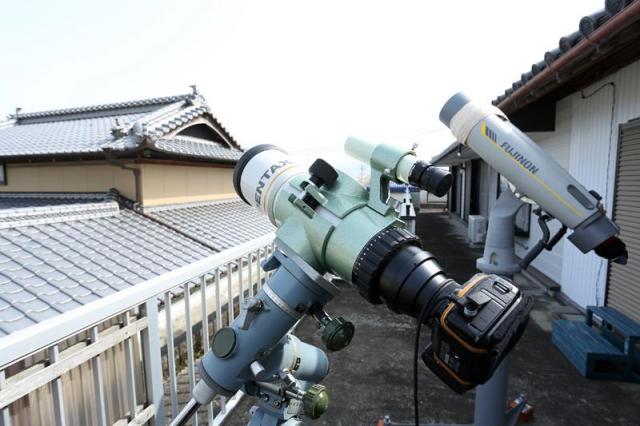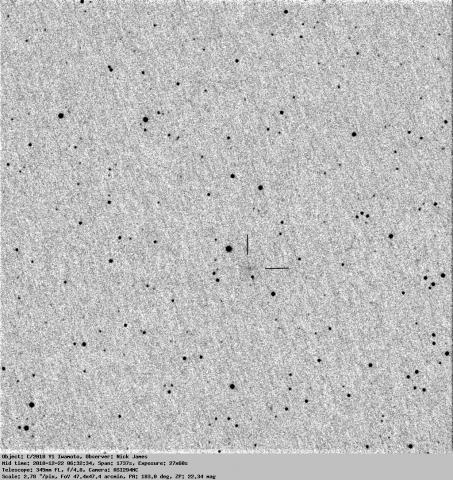- This topic has 7 replies, 5 voices, and was last updated 7 years ago by
 David Swan.
David Swan.
-
AuthorPosts
-
20 December 2018 at 9:32 pm #574210
 Denis BuczynskiParticipant
Denis BuczynskiParticipantJon Shanklin writes in the latest BAA Comet discussion list:
2018 Y1 (Iwamoto) “Masayuki Iwamoto (Awa, Tokushima, Japan) discovered another comet in images taken on December 18.84 with a 10-cm f/4.0 Pentax SDUF II telephoto lens and a Canon EOS 6D camera. The comet was around 13th magnitude with a well condensed coma. It had been posted on the PCCP as IF032. [CBET 4588, MPEC 2018-Y52, 2018 December 20] The very preliminary orbit suggests that the comet might have been discoverable by a southern hemisphere survey telescope earlier in the year. It then passed through solar conjunction and has just emerged into the morning sky. The comet is probably approaching perihelion in late January at 1.1 au and may then pass 0.2 au from the Earth in early February when it could be 6th magnitude. The preliminary orbit is based on an arc of only two days and should be regarded as very provisional. JPL give the 1-sigma uncertainty in the date of perihelion as 110 days and in q as 1.4 au. It may become visible from the UK in mid January, but will be a morning object until its close approach.” Attached a couple of images, one of the man himself (Iwamoto) and the other his discovery equipment a 10-cm f/4.0 Pentax SDUF II telephoto lens and a Canon EOS 6D camera.


Attachments:
21 December 2018 at 7:24 am #580420 Nick JamesParticipant
Nick JamesParticipantMany congratulations to Masayuki Iwamoto. The comet is currently low in the morning sky on the border of Hydra and Libra slowly moving north and crossing into Virgo in mid-January. As Jonathan says the orbit is currently very uncertain. As soon as we get a bit more astrometry I’ll post some charts here.
As a challenge it may be currently observable from the UK. From Chelmsford it is currrently around 10 degrees elevation in the SSE at the start of nautical twilight (around 0640 UT). This is 10 deg lower and a bit to the right of where Venus is.
21 December 2018 at 5:50 pm #580422Neil Morrison
ParticipantDedication rewarded. We are being spoilt with the prospect of another good Comet. A great Xmas present and the prospect of a great observing year in 2019
22 December 2018 at 7:11 am #580424 Nick JamesParticipant
Nick JamesParticipantAt a declination of -24deg and only 10 deg above the horizon at dawn C/2018 Y1 (Iwamoto) is a challenge from the UK. Here’s my image from this morning from Chelmsford. It is currently very slow moving which makes it difficult to get a good orbit. Prospects for it should become clearer over the next few weeks.
 22 December 2018 at 8:55 pm #580427
22 December 2018 at 8:55 pm #580427 Peter CarsonParticipant
Peter CarsonParticipantNick, You must have a good unobstructed SE Horizon to catch C/2018Y1. I worked out that at that AZ I can see down to 12 degs Alt from my observatory. I would have needed to wait until 06.50UT for the comet to clear next doors roof, 10 mins into nautical twilight by which time the sky would have been just too bright… but perhaps I should have tried.
Peter23 December 2018 at 8:03 am #580428 Nick JamesParticipant
Nick JamesParticipantMy main telescope can’t get that low so this was using a portable mount set up at the other end of the garden which has a pretty good southern horizon. This plot shows the brightness of the sky background in the frames of this field. I started imaging just before 05:50 when the comet was about 7 deg aove the horizon and there was some cloud low down. The sky darkened a bit as the comet rose and the cloud cleared and then started to brighten rapidly at 06:30 as dawn arrived. My optimum time was between 06:10 and 06:30 when the sky was at its darkest and the comet was around 10 deg up. Astro twilight started here at 05:57 but my sky low down is so bright from other sources that I didn’t see the effect of the Sun until around 30 mins later. By nautical twilight at 06:39 the sky was brightening rapidly.
 24 December 2018 at 8:18 am #580431
24 December 2018 at 8:18 am #580431 Nick JamesParticipant
Nick JamesParticipantUsing recent astrometry from iTelescope Siding Spring (obtained by myself and Martin Mobberley) the orbit is starting to settle down a bit although it is still very uncertain. The 1 sigma position errors at closest approach in mid February are still around 10 degrees. I don’t think this comet will be particularly bright.
Perihelion 2019 Feb 5.343663 +/- 1.72 TT; Constraint: e=1
Epoch 2018 Dec 23.0 TT = JDT 2458475.5 Earth MOID: 0.2740 Find_Orb
q 1.262 +/- 0.0247 (J2000 ecliptic)
Peri. 357.57 +/- 0.53
Node 146.43 +/- 1.0
e 1.0000 +/- 0 Incl. 160.48 +/- 0.05423 of 25 observations 2018 Dec. 18-23; mean residual 0″.74
24 December 2018 at 10:56 am #580432 David SwanParticipant
David SwanParticipantThanks for the chart, Nick. One to follow at least – even if fireworks don’t arise.
-
AuthorPosts
- You must be logged in to reply to this topic.
